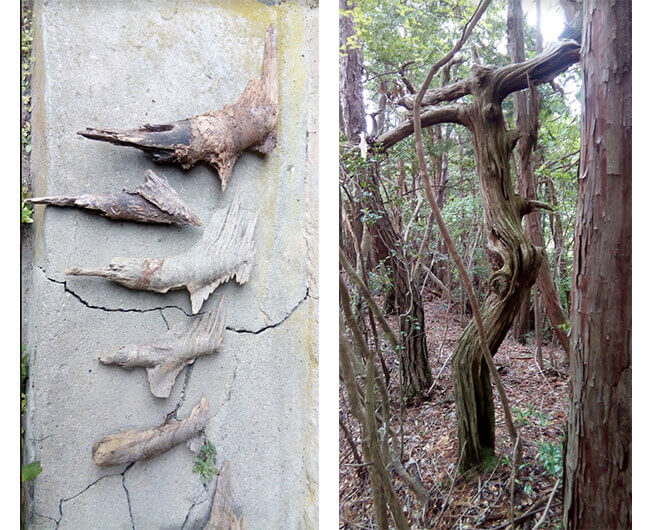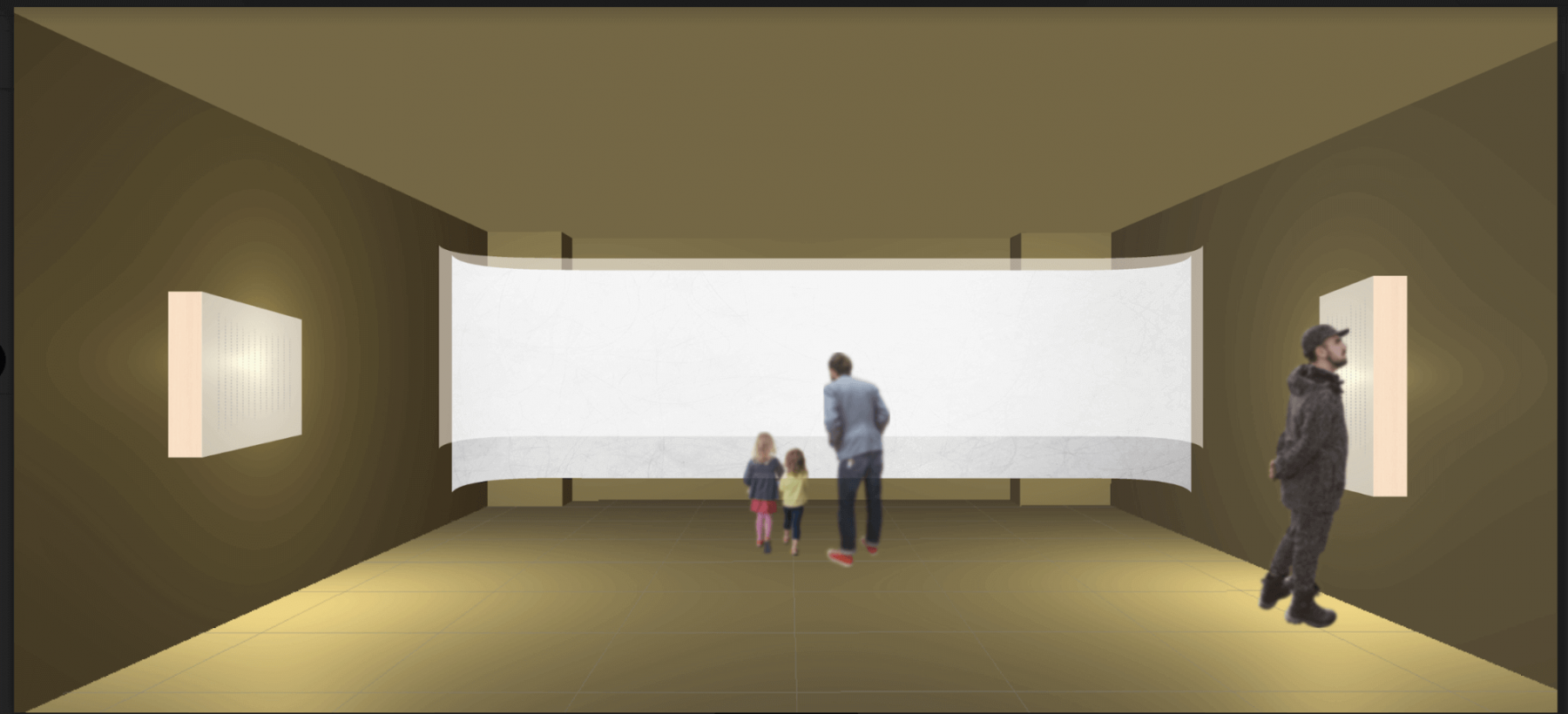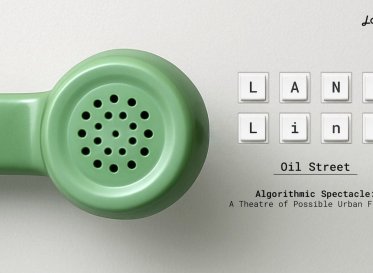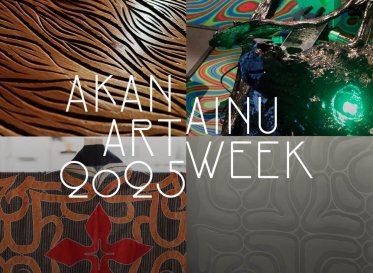Designing an Exhibition for the Japan Kanji Museum & Library: “Kanji Musica” – A Special Exhibition on Sound and Art
The special exhibition “Kanji Musica” will be open from January 10th (Fri) to April 5th (Sun), 2020 at the Japan Kanji Museum & Library (hereafter referred to as “Kanji Museum). Loftwork, Inc. is in charge of planning, coordinating, and exhibition design.
In this exhibition, two artists use sound to creatively depict the moment where kanji (Chinese characters) came into being. Seeing, hearing, touching are all key aspects of this interactive exhibition, with the goal being for visitors to engage with kanji both mentally and physically and thereby create new ways for them to approach the characters.
Where Are Kanji From, and Why Were They Created? Enabling Visitors to Physically Experience the Origin of Characters Through Interactive Exhibits

Japanese characters meet music in “Kanji Musica”, a special exhibition held at the Kanji Museum for three months starting from January 10th (Fri).
The planning for this exhibition began with two sound artists approaching the question of where kanji come from and why they were created, taking into account the natural phenomena, human practices, and writing systems connected to the origins of a wide variety of kanji. This exhibition is interactive, enabling visitors to physically experience the process of how the sights and sounds surrounding us are transformed into writing.
“Spring” is an important keyword for this exhibition. As the exhibition continues through January and February, living things in the earth are preparing for the coming spring, and once March and April arrive, life will be in full movement as the earth begins to bloom again. Accordingly, the strength and vitality of spring are sources of inspiration for the modes of expression on display in the exhibition.
A Collaboration Between Two Sound Artists
Works by Sibitt, a poet and lyricist, and vocal performer and artist Ami Yamasaki are on display in this special exhibition. Both artists use sound to give more tangible form to feelings and sensations otherwise invisible to the human eye. By reorganizing kanji and writing based on their inherent sounds, the exhibition moves away from being purely descriptive and enables visitors to experience the space more freely and intuitively.
Exhibit 1: The Reverberating Gate/ A Monument to Light and Darkness– First Words/Where Is Language From?
The experience begins by passing through a “gate” formed by a poem, transporting the visitor into a new world where they will vicariously experience the origin of the written word. In the following space, a variety of objects personally found by poet, lyricist, and active woodsman Sibitt are on display. Pieces like “A Body for the Transmigration of Mountains”, “Log”, “Entry”, and “Reflective Water” recall the original forms behind a variety of kanji, and visitors can touch and interact with these pieces.
Furthermore, patra leaves will be available for a limited time. These leaves are said to be the original ancestor of postcards, and guests can try writing on them for themselves. An audio guide will also be available, which will include the information written here. For 73 minutes, sound, words, speech, and song play throughout the space, encouraging visitors to create their own stories by interacting with the exhibit. Projected images are also paired with the audio guide so that visitors can visually experience the words of Sibitt.
The pieces featured in “Forms” were discovered in the mountains around Kyoto that Sibitt calls home. A number of these pieces are scheduled to be displayed in the exhibition.



A Word from the Creator
By recreating the fundamental experience of how people engaged with the shapes and sounds of nature at a time when there was no writing, we discover the oral traditions and ways in which we humans transmitted words from one person to another. This interactive experience also presents the moment where we learned to use writing as a means of communication.
Where did language come from? Moreover, where does sound have its origins? Engaging with these fantastical questions is an invitation on a journey to find a flash of insight. How will people pass through the gates, engage with sound, and experience the brilliant moment where the starry glow of writing is discovered amidst the darkness?
Sibitt 志人 (Poet/Lyricist)

In the search for his own unique expression of the Japanese language, this wordsmith has revealed totally new possibilities hidden within words. Sibitt does not confine himself to musical expression, either, engaging in theater and traditional crafts both in Japan and abroad. He also works as a forest ecology researcher and forest ranger, penetrating deep into the surrounding forests and mountains on a daily basis.
Exhibit 2: Voice/ The Light of a Thousand Darknesses and a Thousand Carvings
As visitors pass through a semi-transparent curtain, a 10-meter drawing stretches before them across a “membrane”. Upon touching this “membrane”, countless lines form, just like a real lens. Yamasaki drew these “sounds and echoes” on paper while vocalizing, and exhibition attendees can relive the artist’s experience as they trace the lines with their own hands, making the words their own through a process of rediscovery. There are also a pair of illuminated boxes near the entrance. Yamasaki has carved countless lines into these boxes, which appear and vanish in concert with the lights to evoke rain.
Song blankets the entire exhibition like a spring fog, completing the space and encouraging visitors to experience for themselves the phenomena behind writing and the shape of sound before it was written down.




(Upper right/Upper left/Lower left) Created during FabCafe Kyoto residence. Ami Yamasaki draws over 1,000 lines on a 10-meter canvas while singing.
(Lower right) A piece inspired by rain. Images form slowly as the lights pulse, reminiscent of slow breathing.

A Word from the Creator
(Translator’s note: the following is originally written without using kanji, making it difficult to read and thereby demonstrating how essential kanji are to the Japanese language.)
When trying to understand these letters\ it is kanji that will come to your aid/ they give words texture and depth/ when word and image connect\ kanji also align/ they show the place where mind and thought arise – this piece\ the struggle of the line that wants to be produced and the darkness is creates/as if pulling a single string\ an experience you extract from a knot with meaning/ then\ the sound of kanji\ will be recreated by your and my voice\ and new connections to images will form inside of you
Ami Yamasaki (Vocal Performer/Artist)

Ami Yamasaki uses her own voice and its reverberations in a process similar to echolocation to create performances and installations that draw out the acoustic nuances of spaces. Recently, she has become interested in quantum mechanics, using the voice as a means to explore relations between time and space and how the world is put together.
Exhibition Overview
Special Exhibition “Kanji Musica”
Exhibition Dates: January 10th (Fri), 2020 – April 5th (Sun), 2020
Closed Mondays. In the event that Monday is a national holiday, museum will be closed the following day instead.
Open March 30th (Mon).
Location: Japan Kanji Museum & Library, 2nd Floor
Address: 551 Minamigawa, Gion-cho, Higashiyama-ku, Kyoto
Admission: Exhibition entry included with standard admission.
Organizer: Japan Kanji Museum & Library (Kanji Museum)
Creative Direction: Loftwork, Inc.
Inquiries: Kyoko Iwabashi, Japan Kanji Museum & Library, Japan Kanji Aptitude Testing Foundation/Kanken
Direct line: 075-757-8513
Japan Kanji Museum & Library line: 075-757-8686
Details: https://www.kanjimuseum.kyoto/kikakutenji/detail/200110.html
Next Contents








